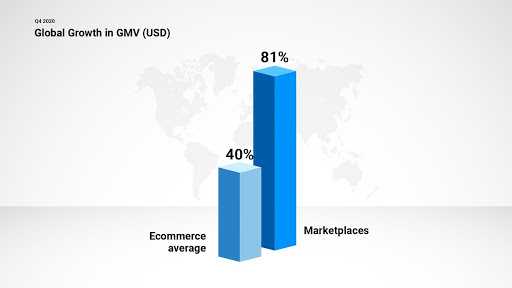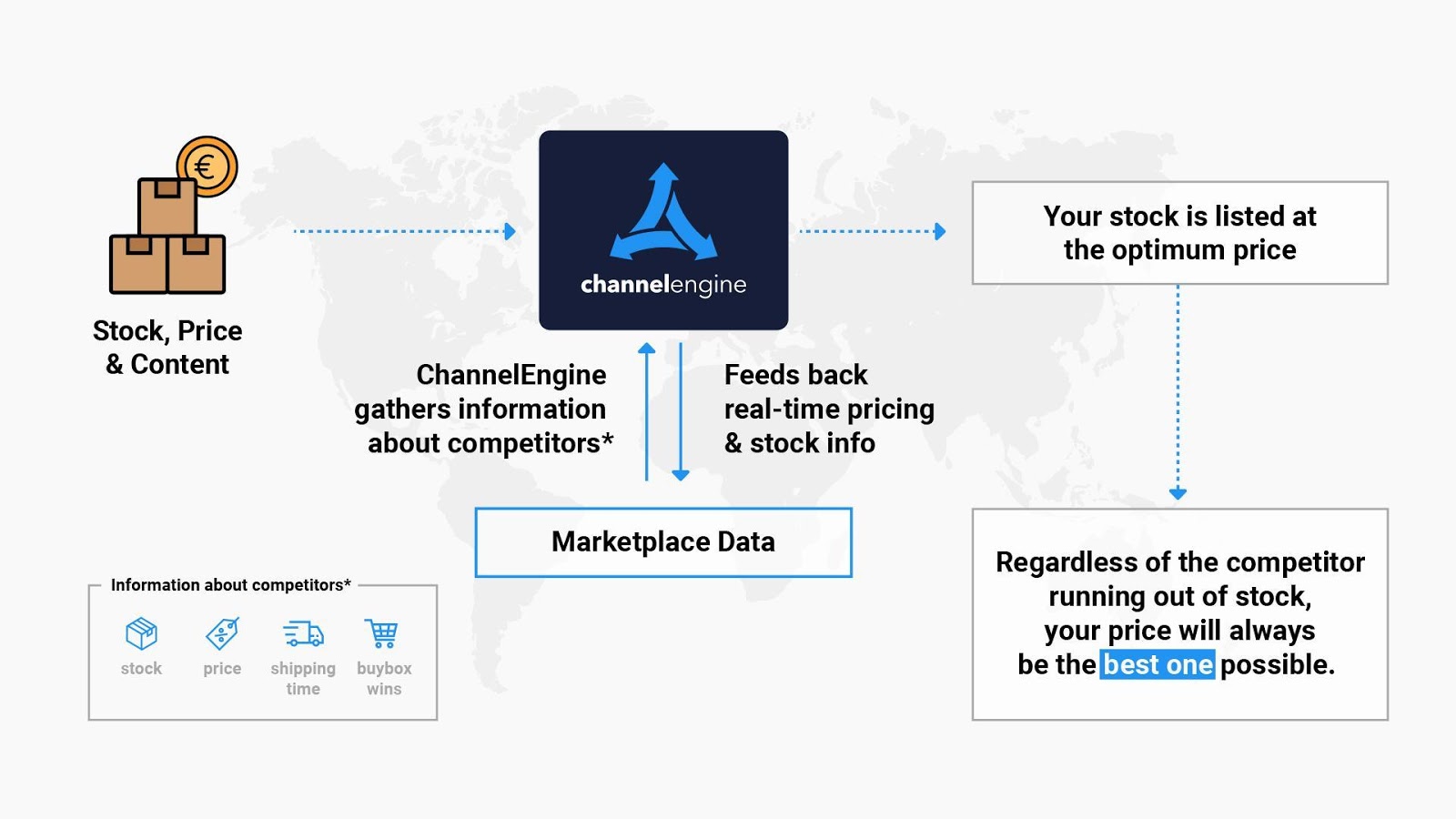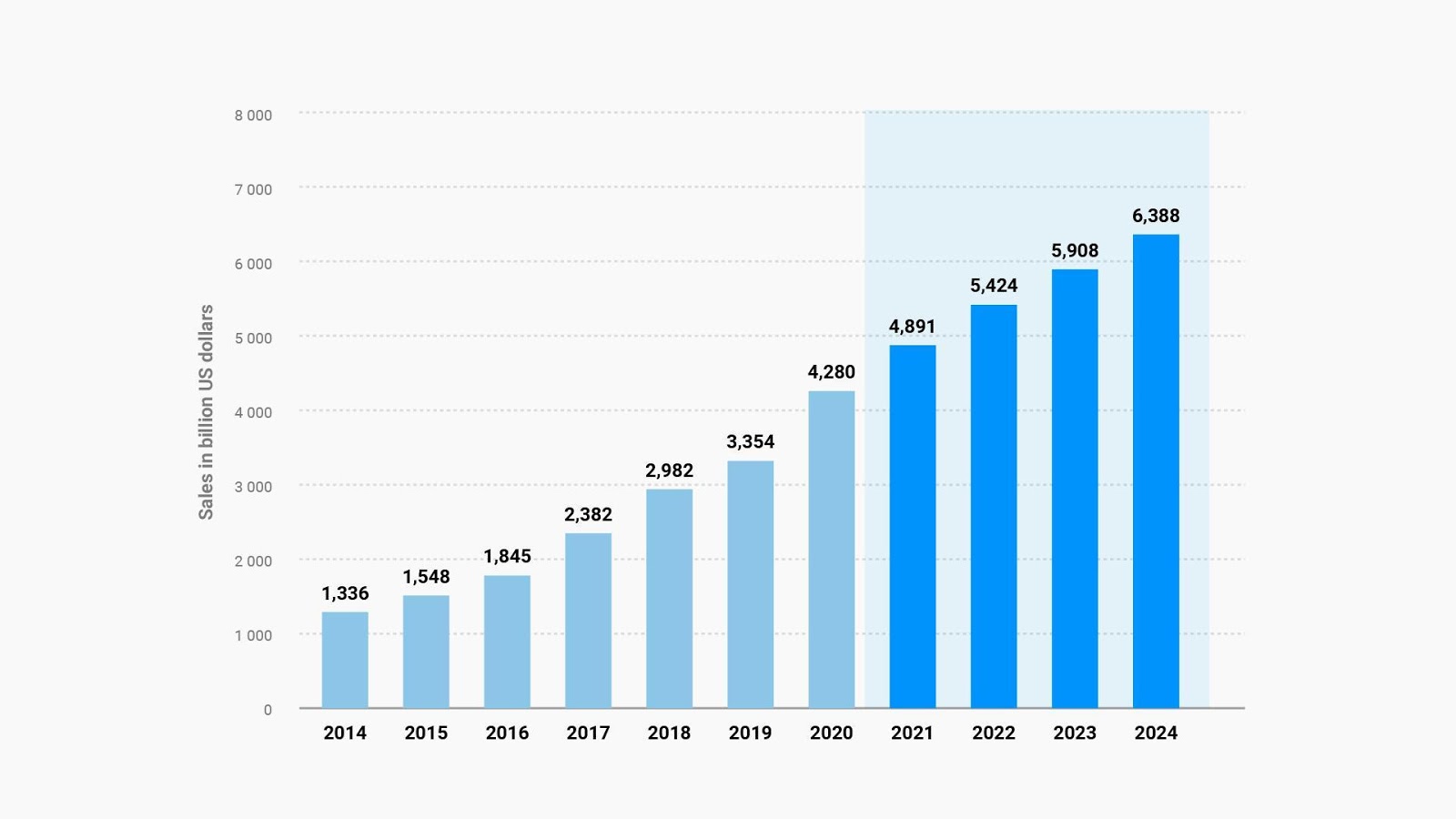Growth twice as strong as the e-commerce average: why marketplaces are the way to go and 6 tips & tricks to start selling
Written by
Editorial TeamPublished on

E-commerce has become a lifeline for many physical retailers in Europe that had to close their doors during the COVID-19 outbreak. So, it is no surprise that online marketplaces are growing rapidly and have experienced a year-on-year increase of 81 percent in the fourth quarter of 2020.
This demonstrates growth that is more than twice as strong as that of the e-commerce industry average. This is shown by the Enterprise Marketplace Index 2021 from Mirakl, the industry’s largest and most comprehensive analysis of third-party marketplace data.

This article will look at why marketplaces are such a valuable asset to retailers and discuss six ‘tips and tricks’ you can use to optimise your selling success.
Online marketplaces also drive website traffic growth
Marketplaces are a great place to reach customers. As a bonus, they also provide a “boost effect” to a retailer’s other e-commerce sites by driving greater product selection and improving the freshness and quality of content.
According to Mirakl’s Index, retailers using the marketplace model saw a 34 percent increase in total organic website traffic. This way, they received higher demand and relevance to their own websites – without additional marketing spend.
The strong growth of online marketplaces is an incentive for retailers to use marketplaces to attract more and more customers, who seamlessly browse third-party offerings in addition to first-party products.
Marketplace providers expanded their seller network by an average of 46 percent last year. Simultaneously, marketplace revenue (Gross Merchandise Volume, GMV) per seller increased by 24 percent. This parallel increase proves that sellers are not cannibalising each other’s growth. In fact, Mirakl’s index shows that adding new sellers leads to incremental growth for everyone: sellers as well as the marketplace operators themselves.
How to make the most of selling on online marketplaces

Fig 2. The Biggest Marketplaces for E-commerce by Country/Region (Source: Herald Bee)
The value of diversification is something Bobbie Ttooulies, Executive Director at GFS, highlights in a previous article:
“Diversification is key to growing sales and spreading the risk. The top 100 marketplaces account for more than 95% of global marketplace sales, so tapping into these marketplaces is a key factor in growing your eCommerce brand. Where retailers can often go straight to Amazon, as the largest marketplace in the world, in fact, the choice of marketplaces is not limited. Alternative marketplaces offer different audiences, demographics, products, and approaches – and the presence of these marketplaces is growing.”
With ChannelEngine, diversifying your sales channels becomes super-easy. With a single, powerful integration, ChannelEngine connects your systems to international marketplaces and sales channels – while optimising sales, minimising time, and maximising profit and reach. It is purpose-built for brands, distributors, and retailers.
Now that the huge opportunity of marketplaces has become clear, the big question is:
How do you sell on them properly to maximise your sales?
To do this, follow these six tips & tricks:
Make a quick scan of your current marketplace efforts
If you are already active on marketplaces like Amazon, Rakuten, or Zalando, the first step is to perform a holistic analysis of your past and current efforts. This analysis should aim to answer the following questions:
- What are your most successful products?
- Can you identify those elements of your service and customer value proposition that have the most significant impact on successful selling? (i.e., price or delivery times, compared with your competitors)
- What content seems to work best?
- Which advertising methods give you the best results?
- What were your failures?
Learning from your mistakes, competitors, and success stories will give you a head start each time you scale-up to another market or marketplace. Make a running list with the subset of your biggest successes, such as products, price, service, customer value proposition, or advertising successes. This will help you keep track of what works best.
Select target markets to scale-up on
If you want to scale-up your marketplace activities, you broadly have two options: Enter new geographic regions within the same marketplace (i.e., Amazon.nl and Amazon.de) or enter new marketplaces within the same geographical area (i.e., Zalando.nl and Otto.nl.)
New geographic regions within the same marketplace are often the most logical choice to scale-up. You already know how the platform works, the fee structure is clear, and you’ve probably already connected it to systems like your ERP, PIM, e-commerce platform, or ChannelEngine. However, the subtle differences between geographic markets (and the accompanying challenges) are often underestimated. This means that the results of your ‘quick scan’ are only partially helpful. The differences between countries (e.g. competition, demand, culture, and demographics) present a challenge to successful selling in these new markets. Hence, it is of importance to do proper research on these potential differences before fully scaling-up. Use trusted and proven models to assess these differences: consider competition with Porter’s Five Forces analysis or cultural differences with Hofstede’s five dimensions. For the analysis of your products’ demand, you can use a tool like Jungle Scout.
Small (but important) sidenote: you should take language differences and costs of translating content and customer service (if applicable) into account when calculating your business case.
New marketplaces within the same geographical region: this is an excellent strategy to scale-up with if the primary goal is to increase market share. Consumers browse and buy on multiple marketplaces. Therefore, you probably need to be on more than one marketplace to target your audience. With this option, you can use a lot of your ‘quick scan’ information. Don’t forget to additionally consider the new marketplaces’ buy box dynamics, fee structure, and advertising possibilities.
You are best advised to write down the pros and cons of your specific situation of the two options above. Based on this, you can then decide if you see the most potential in option 1, option 2, or combining the two.
Not wasting time (and money) with manual product feed management
Now comes the hard part: exporting all your product data to each platform. Both Amazon and eBay offer custom tools to import and export bulk product listings. This generally means using Excel and other software to constantly maintain product and stock information using CSV or XML files. These are then either manually uploaded or made available as product feeds.
This is often seen as a low-risk way of starting to sell across multiple platforms, as it comes with minimal investment in software or third-party solutions. However, it also comes with a strong risk to growth if you continue to use these ‘legacy’ systems for too long.
Quite simply, those manual systems will strangle your growth potential at an exponential rate the longer you continue to use them. This is due to the increase in time required to properly maintain them as your inventory grows.
They have very distinct disadvantages over time, such as:
- Stock levels have to be manually checked and corrected (regularly)
- Overselling or underselling becomes likely due to update lag
- Data field variations such as Product Title, SKU, Descriptions, and other attributes vary across platforms. The requirements for these can be rigorous and can also change frequently, forcing sellers to invest time in optimising for each platform or risk losing visibility (and sales)
- Image requirements can also vary across platforms (as with data-field requirements, these change often, so need regularly updated)
- Pricing structures across platforms can be hard to maintain and adjust (loss of competitiveness or margins)
- It becomes increasingly time-consuming/costly as your product catalog grows
- Variations in description text cannot be easily tested or measured
- Order management must be handled separately through each platform interface
- Customer service and returns must be handled separately on each platform interface
All of the above problems can be characterised as serious time-sucking issues, comprising a need for a regular review process and manual checks. Moreover, non-unified order processing is a major drain on resources due to manual system use. Sure, it may not take a huge amount of extra time to switch between platform interfaces to process a small number of orders from each one, but you will see this ‘small amount’ of time adding up as your sales increase. Eventually, your sales growth will plateau because your business does not have the resources to invest in new lines or increased sales.
To solve this problem, the next step is to use your own website as a central hub for all your sales – across all channels and platforms. This has now become an easy-to-use option, with several providers offering tools allowing full integration with your webshop’s ‘back-end’. This makes it possible to use a single database for all inventory and data-field requirements, as well as using a single dashboard to monitor sales and process orders. A well-designed solution can simply ‘plug-in’ to your existing e-commerce (CMS) solution.
Generally known as product feed management solutions, they offer a variety of functionalities alongside the core functions, such as listings and order management. These require no programming experience or special skills whatsoever. Additionally, they are generally priced in such a way as to make them very attractive options considering the manual working hours saved.
These time-saving solutions are not just for SMEs aiming to scale-up with minimal friction – they are also a vital tool for established brands wishing to expand while updating existing processes to establish lasting efficiencies. That way, brands can ensure that they maintain a competitive edge in the long-term.
Optimizing your feed data
It may seem like an optional extra, but once you have your feed established, it genuinely pays to spend time optimising it in order to make it work better for each platform and channel. This way, you get the best ROI for the time spent setting it up in the first place.
When you are using a product feed management solution (as discussed above), optimising your data is very easy. Many solutions, such as ChannelEngine, are built to take care of this. This happens by ensuring your feed always complies with the specific requirements for each platform or sales channel.
On top of this, a huge advantage is the ability to test different versions of the text, images, and titles. Moreover, you’re able to compare data on how well they perform efficiently. It’s simply not possible to do that efficiently using a manual ‘legacy’ system.
Repricing competitively to keep stock moving
Pricing is another area where optimisation is desirable. This is easily achieved with the right feed management solution as well. Look out for a solution provider with a dynamic repricing tool to ensure you always outsell your competitors until they run out of stock while preserving your bottom line.
The disadvantages of not repricing to reflect the market’s state cannot be overstated: If your prices don’t converge with the supply-demand curve, your stock will remain unsold. At the same time, your competitors will have theirs flying off the shelves and recouping their costs more quickly to invest in future lines and further expansion.

Fig 3. How ChannelEngine’s repricing tool adjusts your prices in real-time to ensure maximum sell-through and revenue.
Using the right product feed management tool will – once again – make this task easy, whereas it would be nearly impossible to be accomplished manually (in the same amount of time)
Repricing is not just ideal for staying one step ahead of the competition but can also be a vital tool for brands and retailers who sell essentially unique items. It is a complete strategy aiming to keep stock moving under variable selling conditions – and one that ensures long-term growth potential through increased liquidity.
Repricing does not always mean cutting prices either – instead, it is about meeting consumer expectations for the kind of good being sold or their desired spend (often when buying gifts). A higher price can sometimes reassure the quality of goods, which is seen most often in unique or luxury brands. Usually, some experimentation is and should be involved in this matter.
Finding the right price (at the right time) can be challenging to predict and quickly adjust using ‘legacy’ manual feed management systems. Still, with the right tools, a product feed management solution should enable the testing of multiple prices or discounts and provide a measurable guide to future success. If you have more questions about repricing, feel free to check and reach out to ChannelEngine.
Go-live and optimise
Lastly, it is advised to go live on the new platform, either with or without an experiment, before fully scaling-up. For every new market(place), make sure everyone knows exactly when you are going live, and pay extra attention to all the relevant KPIs in your marketplace’s dashboard. Then it’s time to optimise and scale-up again. Most importantly: Don’t forget to write down your learnings before you start over with another marketplace or channel.
Future growth in 2021
Marketplaces are booming and will continue to grow both in sales volume and market share. Despite the ongoing pandemic, the digitalisation of businesses in Europe will result in continuous growth for the industry, which is becoming increasingly omnichannel.
The e-commerce sector expects a definitive growth in product sales in 2021. So, you should scale-up now to seize these opportunities. But be aware that success in one marketplace does not necessarily mean success in the next one. By experimenting and taking the right steps, you will scale-up fast and have a successful 2021 – full of (marketplace)growth.



